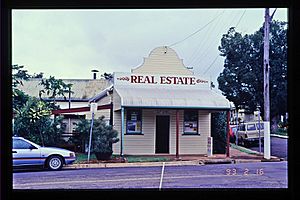Bank of New South Wales building, Yungaburra facts for kids
Quick facts for kids Bank of New South Wales Building, Yungaburra |
|
|---|---|

Bank of New South Wales Building, 1993
|
|
| Location | 27 Atherton Road, Yungaburra, Tablelands Region, Queensland, Australia |
| Design period | 1900 - 1914 (early 20th century) |
| Built | c. 1914 |
| Official name: 27 Atherton Road, Yungaburra, Bank of New South Wales | |
| Type | state heritage (built) |
| Designated | 21 October 1992 |
| Reference no. | 600468 |
| Significant period | 1910s (fabric) c. 1914-1967 (historical use) |
| Lua error in Module:Location_map at line 420: attempt to index field 'wikibase' (a nil value). | |
The Bank of New South Wales Building is an old bank building in Yungaburra, Queensland, Australia. It's located at 27 Atherton Road. This single-storey timber building was built around 1914. For over 50 years, it was home to a local branch of the Bank of New South Wales. Today, it is listed on the Queensland Heritage Register, meaning it's an important historical site.
A Look Back in Time
This building was constructed around 1914. It was built for Arthur Herbert Belson, who was a timber merchant in the area. The building stands on the corner of Atherton Road and Cedar Street.
Yungaburra was first known as Allumbah Pocket. This name meant "red cedar." In 1886, a surveyor named Rankin mapped out the area. This was part of a plan to create new village settlements.
In 1910, the railway line from Cairns reached Yungaburra. The town's name was changed to Yungaburra. This was to avoid confusion with another town. The building was built right across from the new Yungaburra railway station.
In 1926, the Gillies Highway opened. This road connected Cairns to Gordonvale. It brought more tourists to the nearby lakes. This led to a second period of growth for Yungaburra.
The Bank of New South Wales started using this building in 1914. Before that, the bank had been in temporary spots. In 1921, the bank bought the property. Old photos show the building had a single layer of timber walls. There's a fun local story about the bank. One New Year's Eve, some young people moved the railway gates. They put them on the bank's awning! People thought this showed great strength.
In 1965, the Yungaburra bank became an agency. It was linked to the main branch in Atherton. The agency closed in 1967. The Bank of New South Wales sold the building the next year. The current owners bought it in 1988.
What Does It Look Like?
This building has one floor and is made of timber. It has a corrugated iron roof with a pointed shape, called a gable. It's located right in the middle of Yungaburra. When it was first built, its timber frame was visible. Later, it was covered with flat timber boards called chamferboard.
The front of the building faces Atherton Road. It has a curved corrugated iron awning over the entrance. There's also a shaped gable above the awning. The building is now split into two separate areas. The front part has an entrance from the awning. The back part can be entered from a timber deck off Cedar Street.
Most of the windows are sash windows, which slide up and down. Some newer windows are casement windows, which open outwards. A small bathroom has been added to the back corner. The building has been updated recently. It now has new timber floors and some new windows. The area behind the building is a grassy yard.
Why Is It Important?
The former Bank of New South Wales Building is a special heritage site. It was added to the Queensland Heritage Register in 1992.
- It shows how Queensland's history unfolded. The building helps us understand how Yungaburra and the Atherton Tableland grew over time.
- It has a special look and feel. People in the local community value its appearance. Its size, shape, and materials make it a key part of the Yungaburra town.

